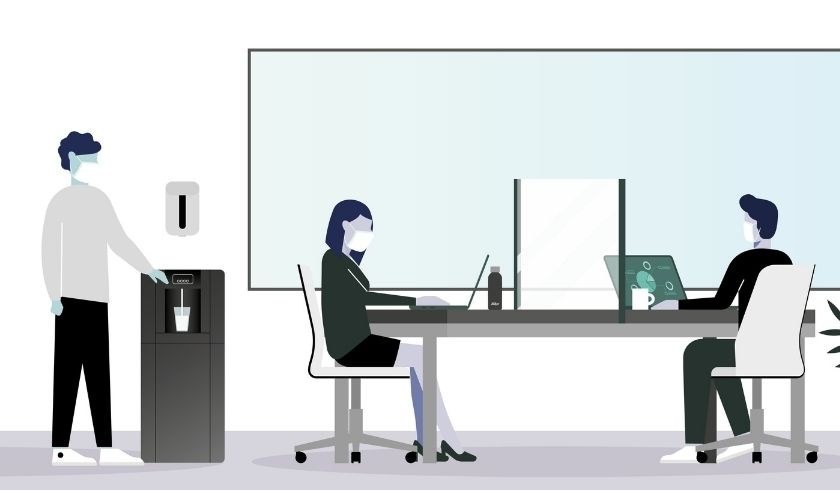01/04/2021
Health and safety of the workforce should be the top priority for employers. Leaders, facilities managers, HR and communications teams should be working together to prepare for a return to the workplace, but what might that look like in the post-pandemic world?
If Covid-19 has taught us anything it’s that you can’t put a price on human relationships.
Maintaining contact, whether physical or digital, has been a coping mechanism for millions. Reaching out, connecting and sharing experiences has been a linchpin in weathering the pandemic, which should inform business leaders about the importance of two things; that empathy and understanding is crucial to harnessing employee confidence, and that everyone’s experience of the pandemic is different.
Be mindful of the stress of commuting, considerate to those who may have been shielding, or compassionate to members of the team with heightened social anxiety.
Showing empathy is crucial, as is understanding that new systems, procedures and methods of working will take time to bed in. After all, without the trust of the workforce this ‘new normal’ just won’t succeed.
Infection control remains workers’ top concern as they come back to their place of work. Whether from colleagues (44%) or customers (33%), employees are most concerned about virus transmission in the workplace [Aviva, June 2020].
Start by ensuring that workers are able to maintain good hygiene. Installing hand sanitation points, increasing the frequency of cleaning routines and reducing touchpoints will all make a big difference to addressing concerns around transmission.
Reconfiguring office layouts, rearranging desks and installing physical barriers may seem like a threat to office culture, but they are key to making staff feel valued, confident and more willing to return.
Whilst employees are generally feeling positive about returning to their place of work, 30% of working adults in the UK are still working exclusively from home [Office of National Statistics Opinions and Lifestyle Survey, March 2021].
Whether this is due to a lack of confidence in workplace safety or simply that the requirements of the job lend to workplace flexibility, business leaders should show willing to adopt flexible working practises.
A recent survey conducted by Chartered Management Institute (CMI) [March 2021] reported that 61% of managers said they expected staff in their organisation to visit their workplace between one and four days a week in future, with the other days spent working remotely.
A slow and steady return is likely to be more successful than an immediate or pressurised one, which could alienate and irritate those whose buy-in employers need now more than ever.
Policies and procedures need to be reframed to take into consideration hygiene and safety.
One-way systems, social distancing and the staggered use of shared recreational space will make employees more mindful of how they conduct themselves and to show respect to colleagues.
Leaders must adopt a clear and concise approach to issues such as staff testing and the ‘stay home if unwell’ policy.
Communicating your stance on these issues is vital but following protocol will be key to making it work.
Leaders who put staff wellbeing at the forefront of their strategy will no doubt bring holistic benefits to the workplace.
Offering mental health support, a mentoring programme or digital personal training sessions will not only make employees feel valued but they demonstrate that bosses are willing to do their bit to heal the hurt of the first year of the pandemic.
Maybe team members have lost loved ones, struggled with anxiety or faced an alarming wake-up call with respect to their own health. Encouraging a fit, healthy workforce not only means better staff retention, but it’s a reinforcement of positive office culture.
Moving forward, companies should implement enhanced safety features and innovations that target concerns to reassure employees.
Leaders must take care of their team in ways they’ve never had to before. This could mean a complete overhaul of ventilation systems or investing in anti-bacterial coatings for shared surfaces.
It goes without saying that touch-free appliances are a must. Here at Zip Water we have a range of contactless drinking water systems including the touch-free HydroTap and chilled water dispenser. As well as reducing touchpoints, they encourage ‘refill culture’ so carry sustainable credentials to boot – a must for forward-thinking office managers.
However your business proceeds, a one-size-fits-all approach does not exist. Each employer will require a strategy tailored to their industry and workforce. That said, one common theme will be communication. Remember, your team is looking to you to keep them informed. Expand internal communications programmes to educate and train employees on new safety protocols and innovations.
And keep talking. After all, this isn’t a sprint. It’s a marathon.

Talk to us about your next project, request a brochure or arrange a full product demo with one of our team.
